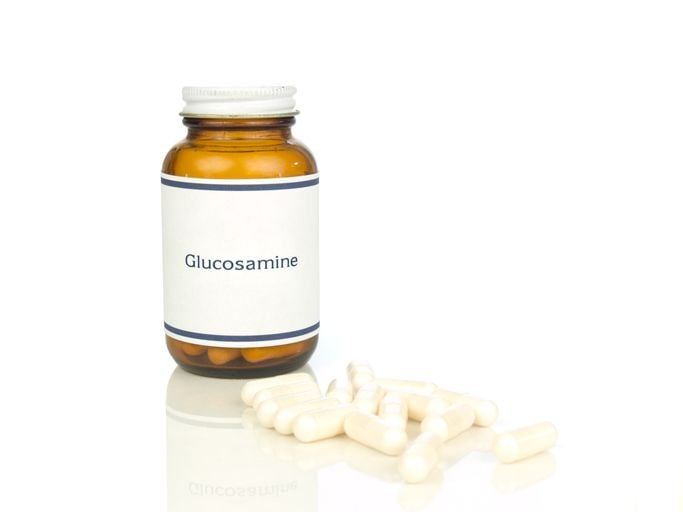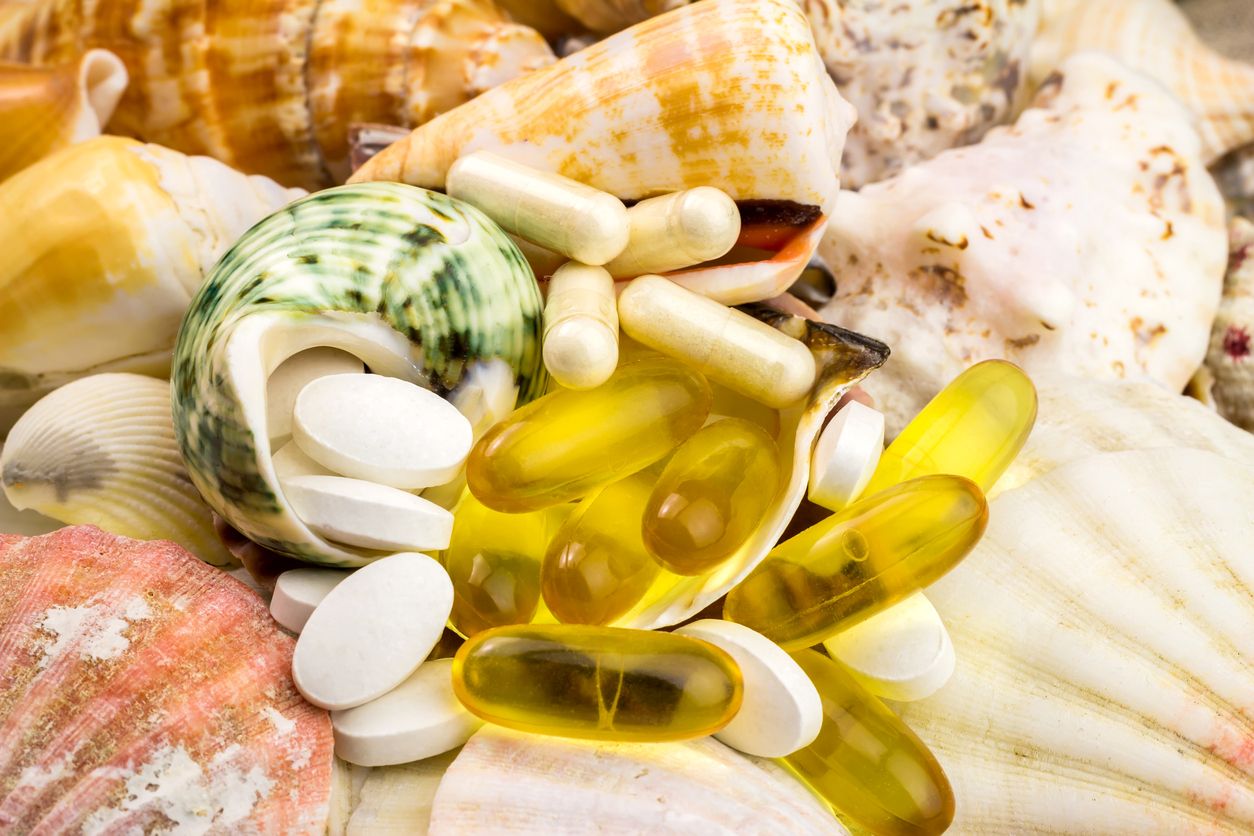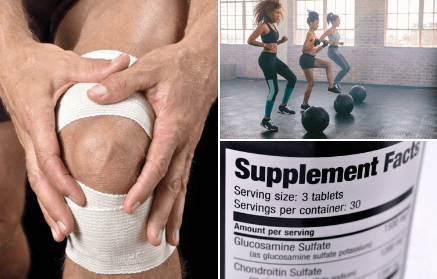Table of Contents
For many years, biomedics have tried to find an easily digestible form of cartilage to help people with joint problems. As a result, many studies have found that Glucosamine Sulfate is one of the building blocks of cartilage, and it is absorbed very quickly and without unnecessary strain on the stomach. [1]
Glucosamine has natural anti-inflammatory properties as well as anti-aging effects. It helps to treat common symptoms of age-related diseases such as arthritis or osteoarthritis. It can also contribute to better digestion and intestinal health, mobility, range of motion and general joint health. All this even in healthy people who have no chronic joint or intestinal disorders.
Essentially, it is an aminosugar that occurs naturally in the bones of animals, bone marrow, crustaceans, fungi or fluids around our joints. It is produced in the body by chondrocytes found in the cartilage to produce healthy joint tissues. [2]
Laboratory tests have shown 98% absorbability of glucosamine, and because its molecules are small and simple, they can penetrate right into the cartilage, helping to build special proteins that keep the cartilage strong and healthy. [1]
You might be interested in these products:
Kurtis Frank, research leader for research.com, provides the easiest way to describe the action of glucosamine as supplements to knee or hip osteoarthritis:
“We are damn sure that glucosamine helps, but we are not sure to what extent. We already know that long-term use of glucosamine sulphate is better than short-term use of glucosamine hydrochloride.”
The use of glucosamine is recommended by many experts but is unlikely to magically reduce the symptoms of osteoarthritis. Therefore, it should be combined with other protective factors such as exercise, low-inflammatory diet, possible use of other supplements.
The main purpose of glucosamine is the formation of long chains called glycosaminoglycans (GAGs), which require joints for regeneration. [2]

How does glucosamine work?
The body uses glukosamine to produce other chemicals that are involved in building tendons, ligaments, cartilage and the fluid that surrounds the joints.
The joints are dampened by the fluid and cartilage surrounding them. In some people with osteoarthritis, cartilage breaks down and becomes thinner. This results in more frequent friction, pain, and joint stiffness. Researchers believe that the use of glucosamine may increase the density of cartilage and fluid surrounding the joints, or at least prevent the degradation of these substances. [3]
We know two basic types of glucosamine:
• Glucosamine Hydrochloride
Although similar, they do not have the same effect when taken as supplements.
Glucosamine is very often used in the field of alternative medicine for arthrosis of the knee (of 47% of people confirming the use of alternative medicine, 59% use glucosamine and the remaining 41% use chondroitin sulphate). [4]
Glucosamine Hydrochloride
Glucosamine Hydrochloride is a reference form of glucosamine due to its simplicity, whose effects have not been shown to be quite beneficial. Many studies in which test subjects used this form of glucosamine do not describe any significant results and recommend the use of another form of glucosamine.

Glucosamine Sulphate – does it really help?
In the above-mentioned meta-analysis, in which a significant benefit of glucosamine hydrochloride could not be found, the effect of glucosamine with sulphate, called glucosamine sulphate, was found. Glucosamine sulphate has better absorbability compared to pure glucosamine for unknown reasons. [5] Glucosamine sulphate appears to be one of the most popular nutritional supplements for athletes and is also used by athletes with osteoarthritis. [6]
A study conducted by cyclists noted that glucosamine sulphate at a dose of 1500 mg-3000 mg daily reduced the circulation of CTX-II (an indicator of collagen degradation) without significantly affecting CPII (an indicator of collagen synthesis).
In many studies, they have noticed that 3 g glucosamine supplementation adjusts the serum indicator, suggesting minor collagen disorders. Collagen synthesis does not appear to be significantly affected, as observed in high-impact sports (football) and low-impact sports (cycling).

Another very interesting study was conducted by researcher Rebecca Braham in the field of epidemiology and preventive medicine at Monash University in Praharn. Rebecca together with two other colleagues examined the effect of glucosamine 2000 mg daily for 12 weeks. In addition, they also included tests that measured joint function and pain in persons with knee pain.
The sample size was relatively small, with 24 people using glucosamine and 22 using placebo. All 46 participants were suffering from knee pain due to previous cartilage damage or osteoarthritis, which was so severe that it limited them during daily activities. The function of the knee joint was measured by walking the stairs and duck walking. Participants also responded to pain questionnaires.
Researchers found that improvement occurred much faster in patients taking glucosamine sulphate (after approximately four weeks of use). The biggest advantage of glucosamine was the reduction in the amount of perceived pain. At the end of the study, 88% of people taking glucosamine sulphate reported that their knee pain improved significantly compared to 17% of people taking placebo. [11]
Nutritional supplements that contain glucosamine sulphate often contain other ingredients. These include Chondroitin Sulphate, MSM or shark cartilage. Some experts believe that the combination of these substances works better than the use of glucosamine alone. [3]
Chondroitin
In some studies, they examined the effect of a combination of glucosamine and chondroitin on painful knee osteoarthritis. 1583 patients were randomized and divided into 5 groups receiving daily use of the following substances for 24 weeks:
- Group 1 received 1500 mg of glucosamine
- Group 2 received 1200 mg of chondroitin
- Group 3 received a combination of glucosamine sulphate and chondroitin
- Group 4 received 200 mg of Celecoxib
- Group 5 received placebo
What were the results of the study?
Glucosamine and chondroitin administered alone or in combination did not reduce the pain of patients with osteoarthritis of the knee. Investigative analyses indicate that the combination of glucosamine and chondroitin sulphate may be effective in patients with severe to severe knee pain. [7] Chondroitin in combination with glucosamine appears to be synergistic in inducing collagen synthesis.

MSM (Methylsulphonylmethane)
Methylsulphonylmethane is a joint nutrition that often occurs alongside glucosamine and chondroitin due to the fact that it participates in joint health. [8] [9]
Usha and M. Naida from the Department of Clinical Pharmacology at the Institute of Medical Sciences in India conducted a study investigating the difference and effect of substances in patients with gonarthrosis for more than 12 weeks. Patients were divided into 4 groups according to the component they were taking:
- Glucosamine (1500 mg),
- MSM (1500 mg),
- Combination of glucosamine and MSM
- Placebo
In the third group using glucosamine and MSM, they experienced markedly reduced pain and minor swelling in the joint area. Thus, they concluded that the combination of MSM and glucosamine sulphate provides better and faster recovery in patients with osteartritis. [10]
Recommended dosage of glucosamine sulphate
Usually our diet does not contain any significant food sources of glucosamine, so it is necessary to obtain it from nutritional supplements. In the form of nutritional supplements, it is mostly made of chitin, hard shells of shrimp, lobster and crab. However, there are other forms of glucosamine that are available for people who are allergic to molluscs.
Allergy to molluscs: Some types of glucosamine sulphate are made of shrimp, lobster or crab. There is therefore a concern that these products may cause allergic reactions in people with shellfish allergy. However, similar allergic reactions are usually caused by shellfish meat.

Glucosamine can be administered in 3 ways:
- Orally (by mouth)
- Transdermally (through the skin) through creams effective against joint pain
- Intramuscularly (into muscle) by injection
Glucosamine should be supplemented for 2 to 4 months before its positive effects occur. [12] Glucosamine supplementation is recommended according to studies to date at a daily dose of 1500 to 2000 mg.

What is your opinion on glucosamine? Do you take it alone or in combination with other ingredients, or as part of a complex joint nutrition? Let us know your thoughts on this joint nutrition and share the post if you liked it.
[1] Kelly GS, The role of glucosamine sulfate and chondroitin sulfates in the treatment of degenerative joint disease, – https://www.ncbi.nlm.nih.gov/pubmed/9600024
[2] Examine.com, Glucosamine, – https://examine.com/supplements/glucosamine/
[3] WebMD, Glucosamine Sulfate, – https://www.webmd.com/vitamins-supplements/ingredientmono-807-glucosamine%20sulfate.aspx?activeingredientid=807&activeingredientname=glucosamine%20sulfate
[4] Sawitzke A., et al., Clinical efficacy and safety of glucosamine, chondroitin sulphate, their combination, celecoxib or placebo taken to treat osteoarthritis of the knee: 2-year results from GAIT., – https://www.ncbi.nlm.nih.gov/pubmed/20525840
[5] S. Vlad, et al., Glucosamine for pain in osteoarthritis: why do trial results differ? – https://www.ncbi.nlm.nih.gov/pubmed/17599746
[6] Vad V, Hong HM, Zazzali M, Agi N, Basrai D., Exercise recommendations in athletes with early osteoarthritis of the knee, – https://www.ncbi.nlm.nih.gov/pubmed/12196032
[7] D. Clegg, et al., Glucosamine, chondroitin sulfate, and the two in combination for painful knee osteoarthritis, – https://www.ncbi.nlm.nih.gov/pubmed/16495392
[8] El-Gindy A, Attia K, Nassar M, Seda H, Shoeib M, Reflectance near-infrared spectroscopic method with Chemometric techniques for simultaneous determination of Chondroitin, glucosamine, and methyl sulfonyl methane, – https://www.ncbi.nlm.nih.gov/pubmed/22970568
[9] Tsui T, Boon H, Boecker A, Kachan N, Krahn M, Understanding the role of scientific evidence in consumer evaluation of natural health products for osteoarthritis an application of the means end chain approach, – https://www.ncbi.nlm.nih.gov/pubmed/23107559
[10] Usha P., Naidu M., Randomised, Double-Blind, Parallel, Placebo-Controlled Study of Oral Glucosamine, Methylsulfonylmethane and their Combination in Osteoarthritis, – https://www.ncbi.nlm.nih.gov/pubmed/17516722
[11] Braham R., Dawson B., Goodman C., The effect of glucosamine supplementation on people experiencing regular knee pain, – https://www.ncbi.nlm.nih.gov/pubmed/12547742
[12] Steven D. Ehrlich, Glucosamine, – https://umm.edu/health/medical/altmed/supplement/glucosamine

